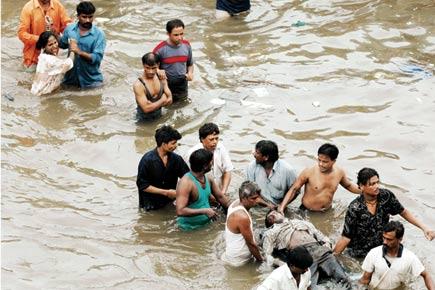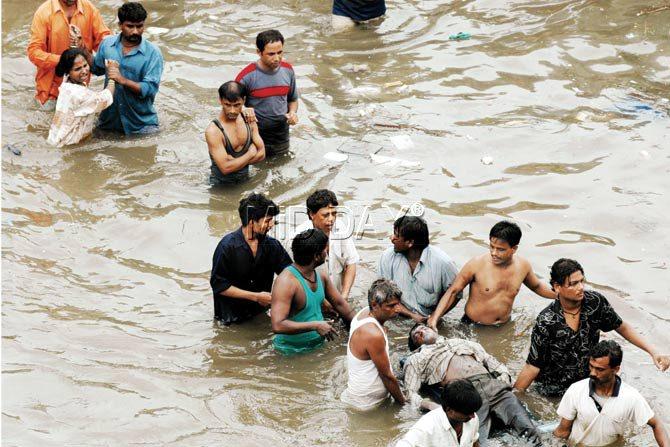Ten years of planning and trying to learn the lessons from the July 2005 floods seem to have been in vain. In his latest book, this time on climate change, Amitav Ghosh discusses why Mumbai needs an evacuation plan. Excerpts:

 At around 5 p.m. cellular networks failed; most landlines stopped working too. Soon much of the city’s power supply was also cut off (although not before several people had been electrocuted): parts of the city would remain without power for several days. Two million people, including many schoolchildren, were stranded, with no means of reaching home; 1,50,000 commuters were jammed into the city’s two major railway stations. Those without money were unable to withdraw cash because ATM services had been knocked out as well.
At around 5 p.m. cellular networks failed; most landlines stopped working too. Soon much of the city’s power supply was also cut off (although not before several people had been electrocuted): parts of the city would remain without power for several days. Two million people, including many schoolchildren, were stranded, with no means of reaching home; 1,50,000 commuters were jammed into the city’s two major railway stations. Those without money were unable to withdraw cash because ATM services had been knocked out as well.
ADVERTISEMENT
Road, rail and air services would remain cut off for two days. Over 500 people died: many were washed away in the floods; some were killed in a landslide. Two thousand residential buildings were partially or completely destroyed; more than ninety thousand shops, schools, healthcare centres and other buildings suffered damage.

The body of a victim in the July 26, 2005, floods being taken away by friends and relatives. File pic/Pradeep Dhivar
While Mumbai’s poor, especially the inhabitants of some of its informal settlements, were among the worst affected, the rich and famous were not spared either. The most powerful politician in the city had to be rescued from his home in a fishing boat; many Bollywood stars and industrialists were stranded or trapped by floodwater.
Through all of this Mumbaikars showed great generosity and resilience, sharing food and water and opening up their homes to strangers. Yet, as one observer notes, on 26 July 2005, it became ‘clear to many million people in Mumbai that life may never be quite the same again. An exceptional rainstorm finally put to rest the long prevailing myth of Mumbai’s indestructible resilience to all kinds of shocks, including that of the partition’.
In the aftermath of the deluge, many recommendations were made by civic bodies, NGOs and even the courts.
But ten years later, when another downpour occurred on 10 June 2015, it turned out that few of the recommended measures had been implemented: even though the volume of rainfall was only a third of that of the deluge of 2005, many parts of the city were again swamped by floodwater. What does Mumbai’s experience of the downpour of 2005 tell us about what might, or might not, happen if a major storm hits the city? The events will, of course, unfold very differently: to start with, a cyclone will arrive not with a few hours’ notice, as was the case with the deluges, but after a warning period of several days. Storms are now so closely tracked, from the time they form onwards, that there is usually an interval of a few days when emergency measures can be put in place.
Of these emergency measures, probably the most effective is evacuation. In historically cyclone-prone areas, like eastern India and Bangladesh, systems have been set up to move millions of people away from the coast when a major storm approaches; these measures have dramatically reduced casualties in recent years. But the increase in cyclonic activity in the Arabian Sea is so recent that there has yet been no need for large-scale evacuations on the subcontinent’s west coast. Whether such evacuations could be organized at all is an open question. Mumbai has been lucky not to have been hit by a major storm in more than a century; perhaps for that reason the possibility appears not to have been taken adequately into account in planning for disasters. Moreover, here, ‘as in most megacities, disaster management is focused on post-disaster response’.
In Mumbai, disaster planning seems to have been guided largely by concerns about events that occur with little or no warning, like earthquakes and deluges: evacuations usually follow rather than precede disasters of this kind. With a cyclone, given a lead-up period of several days, it would not be logistically impossible to evacuate large parts of the city before the storm’s arrival: its rail and port facilities would certainly be able to move millions of people to safe locations on the mainland. But, in order to succeed, such an evacuation would require years of planning and preparation; people in at-risk areas would also need to be educated about the dangers to which they might be exposed. And that exactly is the rub-for in Mumbai, as in Miami and many other coastal cities, these are often the very areas in which expensive new construction projects are located. Property values would almost certainly decline if residents were to be warned of possible risks-which is why builders and developers are sure to resist efforts to disseminate disaster-related information. One consequence of the last two decades of globalization is that real estate interests have acquired enormous power, not just in Mumbai but around the world; very few civic bodies, especially in the developing world, can hope to prevail against construction lobbies, even where it concerns public safety. The reality is that ‘growth’ in many coastal cities around the world now depends on ensuring that a blind eye is turned towards risk.
Even with extensive planning and preparation the evacuation of a vast city is a formidable task, and not only for logistical reasons. The experience of New Orleans in the days before Hurricane Katrina, or of New York before Sandy, or the city of Tacloban before Haiyan, tells us that despite the most dire warnings large numbers of people will stay behind; even mandatory evacuation orders will be disregarded by many. In the case of a megacity like Mumbai this means that hundreds of thousands, if not millions, will find themselves in harm’s way when a cyclone makes landfall. Many will, no doubt, assume that having dealt with the floods of the recent past they will also be able to ride out a storm.
(Extracted with permission from The Great Derangement: Climate Change and the Unthinkable by Amitav Ghosh, published by published by Penguin Random House)
 Subscribe today by clicking the link and stay updated with the latest news!" Click here!
Subscribe today by clicking the link and stay updated with the latest news!" Click here!






